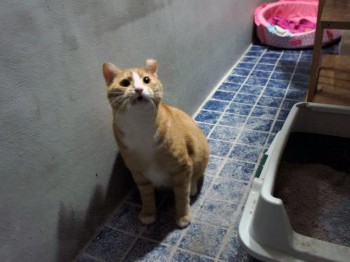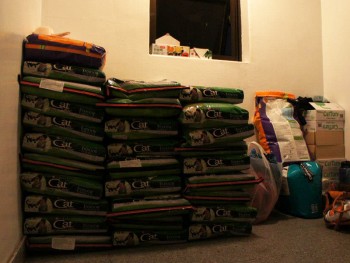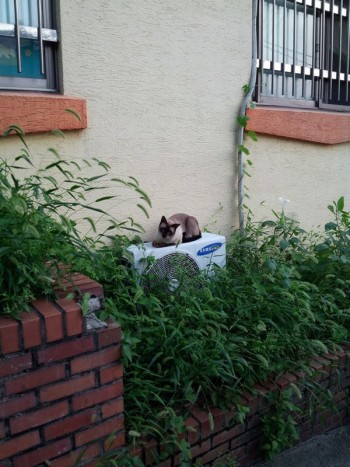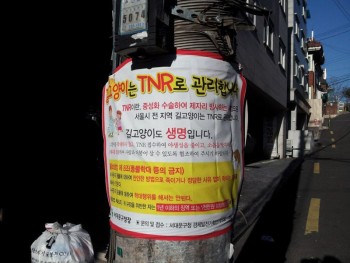This article was compiled by interviewing five women involved in the Korean Government run Trap-Neuter-Return (TNR) program in Seoul in December, 2012. These women are volunteers, giving their personal time, and often money, to aid the stray cats in their area.
How was Seoul’s TNR program created?
The TNR program began in the Sinchon, Edae, and Hongdae areas of Seoul four years ago in an effort to better control the stray cat population. The program is sponsored by the government in all parts of the city, but volunteers are needed in each district to carry out the work of trapping and contacting the government when a cat must be TNRed.
What are the logistics for trapping-neutering- and releasing the cats?
The government pays for low cost spays and neuters with funds allocated for the project. Volunteers are to trap the cats in need of TNR, then call the government office when a cat is trapped. The office calls a service that picks up strays, and the service drops the cat at a vet designated by the government for the low cost spays and neuters. The vet calls the service when the recovery time is complete, and the service returns the cat to the area he/she was picked up.
The tip of the cat’s left ear is snipped when at the vet’s for easy identification as to whether the cat has been altered or not. Males are held at the vet for 1-2 days, and females for 2-3 days. The strays are very stressed when trapped, transported, spayed/neutered, and held for recovery, but their health takes precedence over their comfort for those few days.
 If a TNR cat is found to be a stray or homeless pet rather than a feral cat, volunteers may take the cat in to foster, but this is not part of the government's program. The cat to the left was TNRed and is fostered by a woman who is a building landlord and has a separate small room for any TNR cats she takes in.
If a TNR cat is found to be a stray or homeless pet rather than a feral cat, volunteers may take the cat in to foster, but this is not part of the government's program. The cat to the left was TNRed and is fostered by a woman who is a building landlord and has a separate small room for any TNR cats she takes in.
The local government, the volunteers explain, has capped the number of animals TNRed per year (due to budget) at 200 cats in each district. Hopefully though, as is the goal of TNR, the population will be greatly reduced and there will be less need to TNR as time passes.
Do the volunteers help cats beyond the government’s funding for TNR?
The TNR volunteers, are “caretakers” in traditional TNR terminology, yet these women refer to themselves as “cat moms.” The cat moms know TNR is a way to protect the cats, and to decrease the number of strays for future generations. While the primary purpose of the volunteers for the government is to trap-neuter- and return, the cat moms take it upon themselves to provide daily food and water, as well as shelter, foster homes, forever homes, public education, vetting, and comfort to the cats they care so much for.
 There is also a website for those who volunteer for the government’s TNR program to support one another, share stories, post adoptable felines, and educate about proper care for the cats. While TNR is helpful for Seoul’s stray feline population, it is not met without opposition nor is it without emotional challenges and finding flaws in the program for the cat moms.
There is also a website for those who volunteer for the government’s TNR program to support one another, share stories, post adoptable felines, and educate about proper care for the cats. While TNR is helpful for Seoul’s stray feline population, it is not met without opposition nor is it without emotional challenges and finding flaws in the program for the cat moms.
At this time, ten cat moms, in the Sinchon, Edae, and Hongdae area care for 80 cats. They pay for any vaccinations or emergency hospitalization out of pocket. And 170 kilograms of food purchased each month is also voluntarily purchased by the cat moms from their own personal funds.
What hardships do volunteers endure on their mission to help the cats?
They face argumentative neighbors, low budgets, ill or injured cats, and dead kittens.
How do cat moms manage issues with neighbors?
To combat ill-informed neighbors, they hang flyers made by the government for the program and discuss TNR with interested members of the community. They share, “Many people think that feeding the cats will cause the population [to grow], but when they learn that TNR is about reducing the population and caring for the existing animals, they sometimes then support the program and women involved in it.”
Some members of the community even offer their storefront or doorstep to the cat moms for feeding stations. The cat moms never ask others to participate, but they are very supportive of those who aid them in their mission. (For our meeting, we met in a local coffee shop that had bowls outside for food and water for the cats. One of the cats, “Moon,” even visited while we met!) The cat moms’ efforts may aid in spreading TNR outside of Seoul where it is not yet supported. Hopefully as support for TNR grows, so will the government's budget.
What affects volunteers the most?
While the cat moms support the ultimate goal of TNR and volunteer for this program, and provide out-of-pocket additional care to cats, they do find themselves fighting compassion fatigue. Finding dead cats and kittens, or feeling unable to help so many cats in need of vetting or one-on-one care, it is understandable why they may feel overwhelmed.

What is the average lifespan of a Seoul street cat?
The main reasons for death in Seoul’s street cat population, cat moms find, are road kill, disease, and lack of fresh water in winter. The average lifespan of a Seoul street cat is said to be 2-3 years, but it is believed that the high death rate of kittens (with 70-80% dying at 2-3 months old) brings down the average expected age. Cat moms say they see cats 7 or 8 years of age and these cats, though feral and with minor health issues, are doing well.
What do the volunteers hope for the future of the cats and for the future of the program?
While there are many challenges to aiding TNR, the cat moms feel fulfilled in the work they do – that they are helping the community as a whole. They hope the suffering of street cats is lessened by their work, and the education about TNR and cats is increased.
Are there more resources on Seoul's TNR program?
To learn more about Seoul’s TNR programs and volunteers, please visit www.catcare.or.kr – please note this is a community forum in Korean run by the volunteers to support one another and discuss TNR, not a site created by the government program.
Written by Katelin MacNair.



